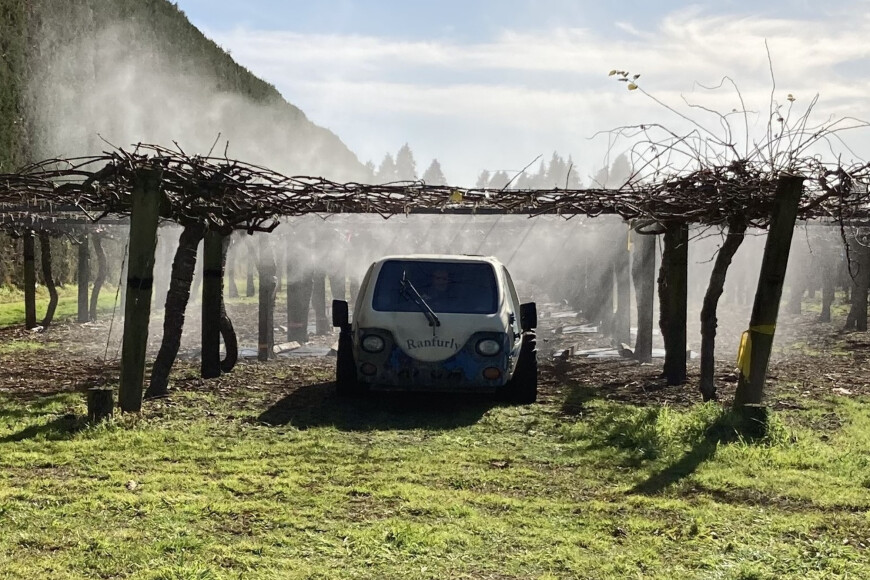
Spraying in progress in the kiwifruit orchard. Plastic covers were used to protect the soil surface and provide unsprayed controls.
However, there is little robust field-based information about the abundance and diversity of soil fauna in Aotearoa New Zealand (AoNZ), or about the effects of common agrichemicals on them. These knowledge gaps have the potential to hamper management decisions in the production sector – as the following example shows.
In 2023, the New Zealand Environmental Protection Authority (EPA) updated its assessment of hydrogen cyanamide, a plant growth regulator widely used by the kiwifruit industry for the promotion of bud growth. Hydrogen cyanamide is applied as a spray once a year over August to September. The reassessment identified a high in-field risk for springtails (Folsomia candida, of the class Collembola), based in part on lab data that suggested hydrogen cyanamide could cause chronic toxic effects in springtails.
However, lab-based work does not fully take account of environmental factors such as the likely more rapid degradation of hydrogen cyanamide in the field, and additional interception associated with soil surface coverings such as litter or grass. With better data urgently needed, the kiwifruit industry asked scientists at Manaaki Whenua to assess the potential effects of hydrogen cyanamide spray on Collembola and other soil fauna in a kiwifruit orchard. A field trial was undertaken in August to September 2023 at a conventionally managed green (Hayward) kiwifruit orchard in Te Puke, Bay of Plenty.
Sampling for soil invertebrates and soil chemistry was undertaken three times: pre-spray, within 24 hours of spraying, and 6 weeks post-spray. Control plots were temporarily covered with plastic sheets during the spraying.
The most obvious finding was a marked increase in Collembola abundance, and other soil fauna, at 6 weeks post-spray, which was attributed to seasonal variation. Critically, there were no significant differences in total Collembola abundance or type, or other soil fauna including mites (Acariformes) and ants (Formicidae), between control and treatment plots at any time-point during the study – suggesting that hydrogen cyanamide did not have any effect on soil fauna in this field study. There was minimal variation in most soil characteristics between individual plots, between control and treatment plots, and over time. Soil chemistry was generally within established soil quality target values.
These preliminary field results suggested that the in-field risk of hydrogen cyanamide for soil organisms was lower than the EPA had thought. These new findings were submitted to the EPA and presented to the EPA decision-making committee for the reassessment in February 2024, which subsequently concluded that with controls in place, the risks to in-field soil organisms from the application of hydrogen cyanamide to orchards are indeed negligible.
This type of field study is important for assessing the impacts of agrichemicals in other horticultural and agricultural systems, including better understanding of the wider potential effects of different management practices.
Funding for this study was provided by New Zealand Kiwifruit Growers Incorporated and by Zespri.
Analysis of pesticide residues in soils from the Greater Wellington region
Manaaki Whenua’s experts in soil contaminants were recently asked by Greater Wellington Regional Council to analyse and interpret data on pesticide residues at 100 non-urban State of the Environment soil quality monitoring sites.
Sites sampled included dairy, drystock, perennial horticulture, arable cropping, vegetable cropping, lifestyle, plantation forestry and indigenous vegetation. Soil samples collected between 2020 and 2024 were analysed for pesticide residues including organochlorines, non- organochlorines and glyphosate by Hill Laboratories and AsureQuality. Our role was to collate the data, identify “nominal concentrations of concern” (NCOCs) and to assess whether any of the samples showed readings above NCOCs, and to advise on ongoing sampling.
Pesticide residues were present in 70 of the 100 samples across all land-uses. Only 12 sites across all land uses had any residues above NCOC. Consistent with general patterns of pesticide use in New Zealand, these sites were confined to arable, vegetable and perennial horticulture. It was noted that results could have been influenced by pesticide application close to the time of sampling. Overall, pesticide concentrations were judged unlikely to cause any negative environmental impacts.
This work will enable the council to decide whether further monitoring or research is needed to understand the implications of pesticide use in land management.
